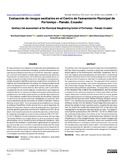| dc.rights.license | http://creativecommons.org/licenses/by-nc-sa/3.0/ve/ | es_VE |
| dc.contributor.author | Delgado–Demera, María Hipatia | |
| dc.contributor.author | Proaño–Morales, Jonathan Josué | |
| dc.contributor.author | Delgado–Demera, María Margarita | |
| dc.contributor.author | Burgos–Briones, Gabriel Alfonso | |
| dc.contributor.author | Cedeño–Palacios, Carlos Alfredo | |
| dc.date.accessioned | 2024-03-01T04:32:53Z | |
| dc.date.available | 2024-03-01T04:32:53Z | |
| dc.date.issued | 2024 | |
| dc.identifier.issn | 0798-2259 | |
| dc.identifier.uri | http://www.saber.ula.ve/handle/123456789/50234 | |
| dc.description.abstract | El riesgo sanitario en el matadero corresponde a las probabilidades que
tiene la carne de contaminarse biológica, química o físicamente con
agentes perjudiciales presentes en el ambiente, materiales, equipos,
por una incorrecta higiene e inadecuada manipulación de operarios
intencional o no intencional y otros factores, que podrían poner en
peligro la salud o la vida humana como resultado a una exposición,
siendo necesario identificar para los respectivos correctivos. El
objetivo de la investigación fue evaluar los riesgos sanitarios del
centro de faenamiento en la ciudad de Portoviejo–Manabí, Ecuador.
La investigación fue observacional, descriptiva y cuali–cuantitativa.
La población estuvo conformada por los elementos que integran el
establecimiento, la muestra la integró la línea de procesamiento de
ganado bovino. Se utilizó la observación y el método lógico deductivo,
los instrumentos usados fueron las guías de encuestas y guía de
cumplimiento de buenas prácticas respaldadas por expertos. Para
el procesamiento de las encuestas se utilizó el software Tableau
Desktop versión 2023.1. En el procesamiento estadístico se manejó
el software RapidMiner Studio versión 9.9, se usó el algoritmo de
Random Forests para obtener el peso de cada pregunta y visualizar el
árbol de decisión, para ellos se entrenó el modelo con el 30 % de los
datos; éste se aplicó para las encuestas de operarios y veterinarios.
El trabajo de investigación contó con la autorización CBI–UTM–INT–
23–03–01_MHDD del Comité de Bioética Institucional de la Universidad
Técnica de Manabí. Los riesgos de que la carne se contamine están
relacionados con la infraestructura antigua del matadero, falta
de gestión de residuos e insuficiente capacitación de operarios
que concuerdan con el nivel de cumplimiento de Buenas Prácticas
MEDIO; debe considerarse una alerta para la salud de la ciudadanía. Es
necesario la implementación de programas de formación a operarios
para concienciar sobre higiene y manipulación adecuada de la carne
y estrategias sostenibles de gestión de residuos. | es_VE |
| dc.language.iso | es | es_VE |
| dc.publisher | SaberULA | es_VE |
| dc.rights | info:eu-repo/semantics/openAccess | es_VE |
| dc.subject | Riesgos | es_VE |
| dc.subject | Carne segura | es_VE |
| dc.subject | Matadero | es_VE |
| dc.subject | Seguridad alimentaria | es_VE |
| dc.title | Evaluación de riesgos sanitarios en el Centro de Faenamiento Municipal de Portoviejo – Manabí, Ecuador | es_VE |
| dc.title.alternative | Sanitary risk assessment at the Municipal Slaughtering Center of Portoviejo – Manabí, Ecuador | es_VE |
| dc.type | info:eu-repo/semantics/article | es_VE |
| dc.description.abstract1 | The sanitary risk in the slaughterhouse corresponds to the probabilities
that the meat is biological, chemical or physically contaminated by
hazard agents in the environment, materials, equipment, due to
incorrect hygiene and mishandling due to intentional or unintentional
operators and other factors that could be dangerous human health
or life as a result of exposure, and that it is necessary to identify for
the respective corrective measures. The objective of the research
was to evaluate the sanitary risks of the slaughtering center in the
City of Portoviejo–Manabí, Ecuador. The research was observational,
descriptive and qualitative–quantitative. The population consisted
of the elements that conform the establishment, and the sample
consisted of the cattle processing line. Using observation and the
logical–deductive method, and instruments like the survey guides
and the good practice compliance guide backed by experts. For the
process the surveys was used Tableau Desktop software version
2023.1. For statistical processing was used RapidMiner Studio
software version 9.9, the Random Forests algorithm was used to
obtain the weight of each question and to visualize the decision
tree, for which the model was trained with 30% of the data; this
was applied to the operator and veterinarian surveys. The research
work had the authorization CBI–UTM–INT– 23–03–01_MHDD from
the Institutional Bioethics Committee of the Technical University
of Manabí. The risks of meat contamination are related to the old
infrastructure of the slaughterhouse, lack of waste management
and insufficient training of operators, which are consistent with
the MEDIUM level of compliance with Good Practices; this should
be considered as a warning for public health. The implementation of
training programmes for operators to raise awareness on hygiene and
proper meat handling and sustainable waste management strategies
is necessary requirement. | es_VE |
| dc.description.colacion | 1-7 | es_VE |
| dc.description.email | hipatia.delgado@utm.edu.ec | es_VE |
| dc.identifier.depositolegal | pp199102ZU46 | |
| dc.identifier.edepositolegal | ppi201502ZU4665 | |
| dc.identifier.eissn | 2477-944X | |
| dc.publisher.pais | Venezuela | es_VE |
| dc.subject.institucion | Universidad del Zulia (LUZ) | es_VE |
| dc.subject.institucion | Universidad de Los Andes (ULA) | es_VE |
| dc.subject.keywords | Risks | es_VE |
| dc.subject.keywords | Safe beef | es_VE |
| dc.subject.keywords | Slaughterhouse | es_VE |
| dc.subject.keywords | Food safety | es_VE |
| dc.subject.publicacionelectronica | Revista Científica | |
| dc.subject.seccion | Revista Científica: Artículos | es_VE |
| dc.subject.thematiccategory | Medio Ambiente | es_VE |
| dc.subject.tipo | Revistas | es_VE |
| dc.type.media | Texto | es_VE |


